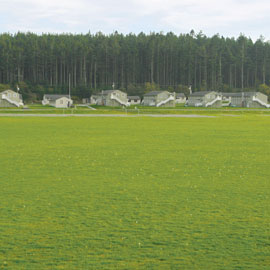 |


|
Winter 2004 | Volume 26, Number 5 | Campus | ||||||
| Planning for Casey’s Future SPU Faces Challenges in Its Efforts to Retain and Maintain Camp Casey FOR NEARLY 50 YEARS, Seattle Pacific University has owned and operated the 300-acre Casey Conference Center — or “Camp Casey” — on the Whidbey Island coastline.
In the mid-1990s, the Seattle Pacific administration and Board of Trustees called for a study of the best use of Camp Casey. At the heart of the issue at that time was a wrenching dilemma: How could SPU afford to operate an aging, high-maintenance conference center that generated relatively small revenue? Could the University steward this asset better by selling all or part of Camp Casey to build endowment for scholarships and academic programs on the main campus? With broad input from all stakeholders and upon the recommendation of the administration, the Board decided to retain Camp Casey, but asked that a plan be created to place the facility on secure financial footing. Specifically, the plan called for retaining the main area of Camp Casey in its current use as a conference facility, and considering sales options for other portions of the property in order to fund improvements to the main conference area. Since then, SPU has been planning for the future of Camp Casey. In March 2002, Seattle Pacific applied with Island County, Washington, for “Special Review District” (SRD) zoning status, a designation that would allow limited improvements to the main conference property in exchange for preservation of its most significant historic and environmental resources. Possible improvements included the construction of 40–50 small retreat cabins, six buildings with townhouse-type retreat units and conferencing space, and a multipurpose educational building. Even with SRD status, any potential building project would have had to meet environmental review and code requirements. The County unanimously approved the application for SRD status in December 2002 after a significant period of public review and comment. A few weeks before the County Commissioners approved Seattle Pacific’s application, a small group called the Whidbey Environmental Action Network (WEAN) raised concerns about a number of issues, such as the cutting of trees and the potential for any improvements to the property to contribute to tree blowdown. “Our proposed master plan would have affected only a relatively small area of Casey’s forest and was designed to minimize the impact on the forest ecology,” says SPU Vice President for Business and Planning Donald Mortenson. “The County Commissioners appreciated this and supported us in the plan.” Following the County’s approval, however, WEAN appealed the decision to the Western Washington Growth Management Hearing Board (WWGMHB), and the original decision was overturned in August 2003 on the basis that the proposed improvements to Casey would constitute urban development in a rural area. Both SPU and Island County were deeply disappointed. “I’m very concerned that (WEAN’s) challenge has created a larger obstacle for SPU to conduct a viable educational opportunity there at Camp Casey,” County Commissioner Mac McDowell was quoted as saying in the August 29, 2003, issue of The Coupeville Examiner. Now Seattle Pacific is considering four options, including submitting an amended application for SRD zoning status; submitting an application for “Existing Master Planned Resort” zoning status (an approach identified as a possibility by the WWGMHB in its ruling); developing the property within the tight restrictions of its current “Rural” zoning status; or selling some or all of the Camp Casey property. The University is also evaluating an offer by a conservation agency to buy substantial acreage in the north portion of the Casey property to hold and preserve while allowing access to it by Camp Casey users. “All of the options have advantages and disadvantages, and each will be studied carefully,” explains Mortenson. “SPU would like to continue to own and operate Camp Casey for the long term, but in order to generate the revenue to do so, we need to create and maintain a conference center that serves a greater number of educational and nonprofit users.” The University has a history of serving the community and the environment, says President Philip Eaton. “Since the beginning of our ownership of Camp Casey,” he adds, “we have worked hard to be good citizens of Whidbey Island, good neighbors and good stewards of this property. We want to do what is right for this magnificent facility and at the same time ensure the responsible management of our resources. We believe we can meet this challenge and find the right solution, one we all can regard as responsible stewardship of land, facilities and the overall resources of SPU.” A copy of a letter from Seattle Pacific to Island County detailing the options being considered by the University is available to anyone who requests it. To receive a copy, email response@spu.edu.
— BY CLINT KELLY |
From the President Circle of Influence Grows Talk About Imagination You Can Go Home Again! Legends of the Falcons My Response |
